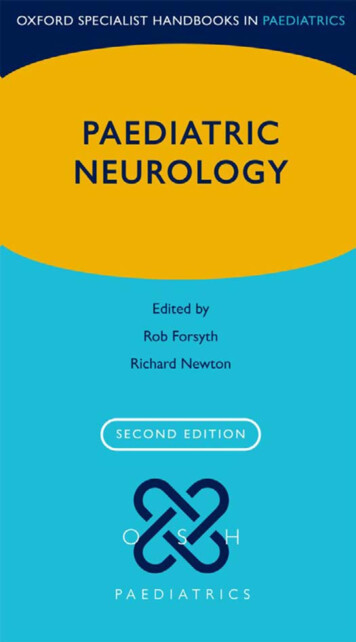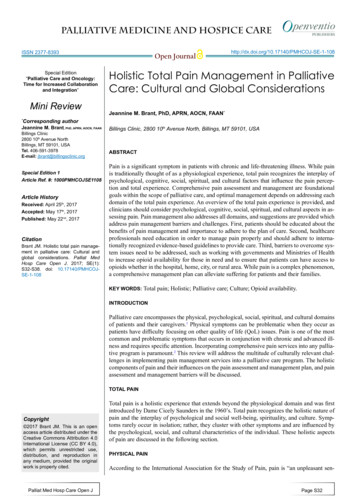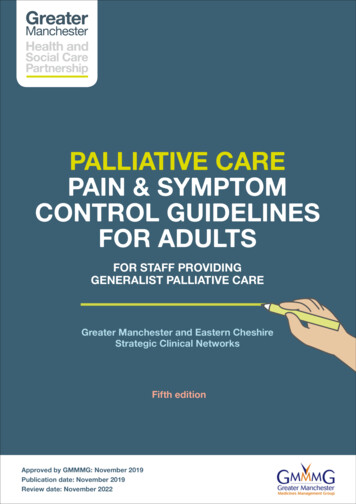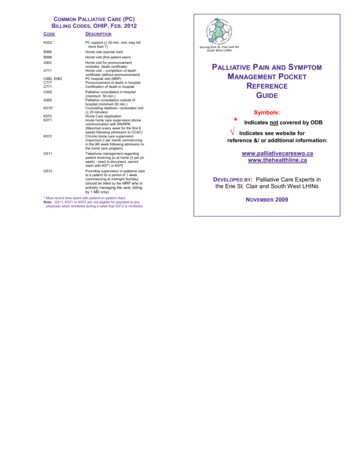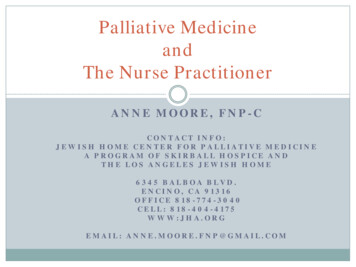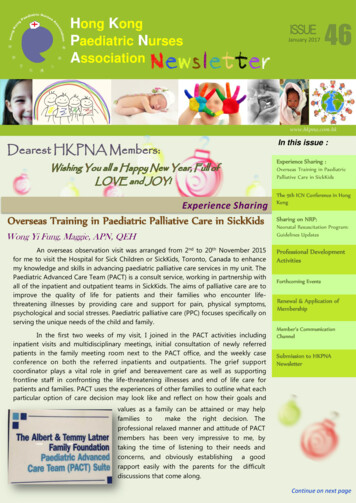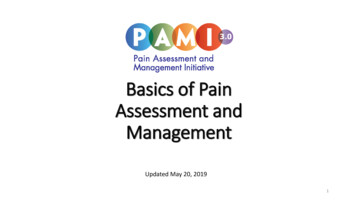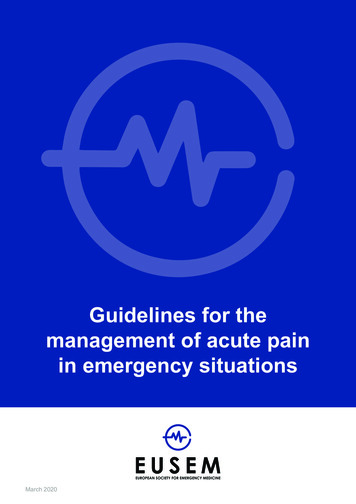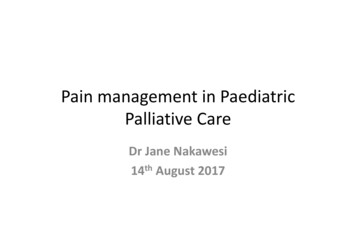
Transcription
Pain management in PaediatricPalliative CareDr Jane Nakawesi14th August 2017
Content Management of pain in children Non pharmacological Pharmacological
Exit level outcomesThe participants will: Know the general principles of painmanagement as described by WHO Understand the realities and misconceptionssurrounding opioid drugs.
What do we understand about pain?
Causes of pain in Children Start from head to toes
Mouth
Ears
Eyes
Parotitis and Lymphadenitis
Shingles
TB abdomen
Arthritis
Nappy rash
Generic Approach to Pain1) Reverse the reversible2) Use Non‐drug measures3) Use Drug measuresa) specific to the causeb) general4) Address associated psychosocial distress5) Continually re-evaluate pain and its response totreatment.e.g. Child with oral thrush1) improve mouth hygiene2) soft foods3) a)topical soothing gel, antifungalb)analgesic4) explanation and reassurance to mother
Reverse the reversible Seek underlying cause Treat what can be treated Stop offending drugs if possible
Non‐pharmacological istractionMusic TherapyEnvironment
How to prescribe medication
Drug measures: Analgesics Correct use of analgesic drugs will relieve painin most children ! 4 KEY CONCEPTS (WHO): By the 2 step approachBy the clockBy the appropriate routeBy the child
WHO analgesic ladder The key to pain management in children is theWHO Analgesic Ladder. The ladder consists of 2 steps, with theprinciple that you start with step 1 analgesicsand if they do not control the child's pain youchange to a step 2 analgesic.
The ‘2‐Step Approach’ New WHO Guidelines 2011 Replaces the ‘WHO ladder’ for children’s pain Weak opioids not recommended in children– Codeine not well metabolised in some children– Tramadol not licensed for use in children andinsufficient evidence
The step 2 approach
fen10‐15 mg/kg 4‐6hrly5 ‐ 10mg/kg 6‐8hrly (max30mg/kg/day)Strong opioid MorphinePO: 0.2 mg/kg 4hrlyIVI bolus: 0.1 mg/kgIVI infusion: 0.003 – 0.05mg/kg/h
Step 2 ‐ Opioid /‐ Non‐opioid /‐Adjuvants The most commonly used step 2 analgesics are: Morphine Sulphate: there are different strengths available e.g. 5mg/5ml,10mg/5ml, 20mg/5ml and 100mg/5ml. 1‐12months of age: 0.08‐0.2mg/kg orally 4 hourly. 12 months of age: 0.2‐0.4mg/kg orally 4 hourly. MST (Slow‐release morphine): Long acting morphine ‐ the dose is determined from the total24 hour requirements
Fentanyl Available as patches ‐ takes up to 24‐48 hours topeak, The dosage is based on the oral morphine doseequivalent per 24‐hour total The smallest fentanyl patch available for use inchildren is 12mcgm which corresponds to a totaldaily dose of 45mg of oral morphine. Patches take 12hours to reach effective blood levels so otheranalgesia such as 4 hourly oral morphine should becontinued for the first 12 hours.
Weak opioids such as codeine phosphate arenot recommended for use in children andshould not be given at the same time asstrong opioids such as morphine.
Classification of sCodeineTilidine (Valoron)TramadolMorphineWeakopioidStrongopioid
By the clock No PRN prescribing in chronic pain On a prn basis, children must experiencepain first before they can get meds – fearthat pain cannot be controlled worsens pain and anxiety Dosage intervals based on duration of action of drugs:4HRLY for opioids Lower dosages of opioids ultimately used and smallerdose needed to prevent a recurrence of a controlled painthan to treat a new pain episode “Rescue dosages” for breakthrough pain
By the appropriate route PO ‐ Use simplest, most effective route IMI – painful, avoidIVI – esp. to titrate strong opioidsSubcut – easier than IVIRectal – may be unpleasantTopical – EMLASpinal/ epidural
By the child Need to adjust meds and dosages accordingto response and side –effects No one dose will be appropriate for everychild Remember: strong opioids have no ceilingdose – titrate to response andside effects
The adjuvant analgesics Important in the management of painOffer a multi‐pronged approach to painEnhance the effects of opioidsTreat concurrent symptoms that exacerbatepain Provide independent analgesia
Site on action of analgesics andadjuvants
The adjuvant analgesics AntidepressantsAnticonvulsantsAntispasmodicsMuscle relaxantsAnxiolyticsCorticosteroids
Peripheral neuropathy Pain usually in legs/ feet Due to– HIV itself and HAART– Post herpetic neuralgia– TB treatment Treatment– Change drugs– Amitriptyline usually first line– Carbamazepine
Pain in Oncology Headache ‐ Prednisone 2 – 4 mg/kg/day Bone pain – NSAID’s, Steroids, Radiation Neuropathic – Opioids, Amitryptiline,Carbamazepine, Regional Anaesthetic Blocks Visceral – Antispasmodics, Opioids
Muscle spasm Paracetamol NSAID’s Baclofen Benzodiazepine – Rivotril (Clonazepam) or Valium(Diazepam)
Case study 1 ‐ John John is 5 years old – 18 kg Fell from a tree andsustained an injury on hisleft arm. He is able to move thehand, but it is painful andswollen. How will you manage hispain?
Case 1 ‐ John John is 5 years old 18 kg Fell from a tree andsustained an injury onhis left forearm. He is able to move thehand, but it is painfuland swollen. How will you managehis pain?1) Reverse the reversible2) Use Non‐drug measures3) Use Drug measuresa) specific to the causeb) General4) Associated psychosocialdistress
Case 1: John1) Reverse the reversible2) Use Non‐drugmeasures3) Use Drug measuresa) specific to the causeb) General4) Associatedpsychosocial distress ? Splint, distraction Paracetamol 15mg/kg16kg x 15mg 240mg 10ml6 hourly Ibuprofen 5mg/kg 16kg x 5mg 80mg 4ml(100mg/5ml)6‐8 Hourly Out of rugby team for 2 weeks,manage disappointment
Case 2 Chris Chris, 7 years old12 kgKnown HIV on ARV’sSevere abdominal pain, due to TB abdomen.How will you manage his pain?
Case 2 ‐ Chris Chris, 7 years old12 kgKnown HIV on ARV’sSevere abdominal pain,due to TB abdomen. How will you managehis pain? Paracetamol 15mg x 12 kg 180mg120mg/5ml7.5ml 6 hourly orally Hyoscine butylbromide5 to 10mg 3 x daily5mg/5ml Morphine sulphate
Morphine myths Myth: It will shorten the child’s life. Truth: Pain control does not shorten a child’s life, it onlyimproves the child’s quality of life and brings comfort to achild’s death. It can even extend a child’s life because they arenot exhausted from fighting pain. Myth: It will suppress a child’s breathing. Truth: Respiratory depression can be avoided by steadyincreases of dose. Myth: It will make the child nauseas. Truth: Nausea may occur in 25% of cases but will normallysettle in 5‐7 days.
Morphine myths Myth: It will make the child even more constipated. Truth: Constipation must be prevented by the early use ofprophylactic laxatives. Myth: They will develop addiction to it. Truth: Addiction is not a problem encountered in paediatricpalliative care. Myth: Sedation will affect the quality of the child’s life in thefinal days. Truth: Sedation will normally improve within a few days oftaking morphine.
Morphine facts Morphine uses (4 A’s) nalgesic nti‐diarrhoeal nti‐tussive naesthesia adjunct
Morphine facts Morphine is a versatile drug with no ceiling effectand no danger of accumulation (except with renalfailure)The dose The correct dose of morphine for an individualpatient is that dose which is effective.Possible routes po,pr,sc,ivi (imi‐ not for ppc) Morphine can be used at any stage of the diseaseto control pain and can be withdrawn if the childno longer needs it ‐ therefore it is used for morethan just end‐of‐life care.
Opioid side areHyperactivityMyoclonusPruritisUrinary Retention
Morphine sulphate Dosage 0.2 mg/kg 4 hourly Strength 100 mg/5mlOr5mg/5mlOr50mg/5ml Weight of child is 12 kg Calculate the dosage of this child using a strength of 5mg/5ml
Morphine sulphate Dosage 0.2 mg/kg4 hourly Strength 5mg/5ml Weight of child is 12 kg Calculate the dosage ofthis child 0.2mg x 12 kg 2.4 mg 2.4ml 4 hourly PO
Morphine sulphate prescription Morphine sulphate (5mg/5ml) give 2.4 mg 2.4ml 4 hourly PO x 5 days. For Break Through Pain 50% of dosageThink about Laxative e.g. Lactulose 5 ml nocte PO Anti‐emetic ‐ Metoclopramide or Haloperidol
How would you increase this? Increase regular dose by 30 – 50% of previousdose– 2.4mg– 3.6mg2.4mg 1.2mg 3.6mg3.6mg 1.8mg 5.4mg After 24 hours add all breakthrough doses and allregular doses and divide by 6 to work out thenew regular 4 hourly dose If breakthrough dose is required 1 hour afterregular dose then the regular dose needs to beincreased
Terminal pain control Oral morphine Sustained release morphine Syringe driver – subcutaneous morphine
Sustained release morphine Given as 12 hourly dose orally Add total daily mg of morphine used if pain iscontrolled and divide by 2 E.g. 2.4 mg x 6 dosages 1.2 mg x 3 (BTD) 14.4 mg 3.6 mg 18 mg total daily dose Only 10, 30, 60 and 100 mg tabs Therefore give 10 mg 12 hourly PO (roundingup)
Terminal pain control with syringe driver Oral to subcutaneous Total daily oral dose / 2 Dilute this amount with normal saline to fill 48mm of the syringe. Set syringe at 2mm/hour
Alternatives to morphine Hydromorphone:– 7x potency of morphine Fentanyl: available as patches (72 h)– takes up to 24‐48 hours to peak Diamorphine– More soluble than morphine Methadone:– Possibly more effective for neuropathic pain
Procedural pain Goal: children to be happy and securebefore and after the procedure “Needle phobia”: 20% of Adults havemoderate-intense fear of needles, blood Fear triggers anxiety, fainting, shock Avoidance of further treatment
How to deal with procedural pain Preparing the environment: Safe, friendly Preparing the adult: Help to calm and distract child, age appropriateinfo. Preparing the child: Topical anaesthetic Allow age appropriate choices Be honest about pain Cognitive e.g. explanation. Distraction e.g. sing song, tell story Relaxation
How to relieve fearGive control– Explain what ishappening– Discuss options– Seek and answerquestionsNon‐pharmacological Rx– Blowing bubbles,progressive relaxation,aromatherapy/massage,play/distraction
pain first before they can get meds -fear that pain cannot be controlled worsens pain and anxiety Dosage intervals based on duration of action of drugs: 4HRLY for opioids Lower dosages of opioids ultimately used and smaller dose needed to prevent a recurrence of a controlled pain
